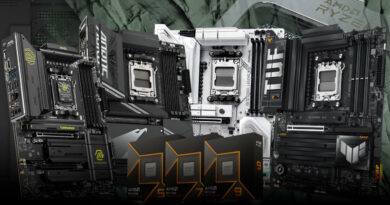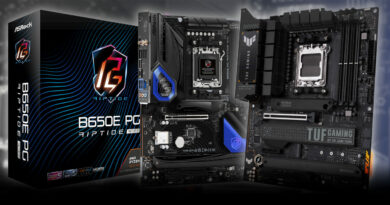Quick Guide on GIGABYTE AORUS X870 and X870E Motherboards!
TalosPC is supported by its audience. We may earn an affiliate commission from qualifying purchases through links on our site.
GIGABYTE has recently announced the launch of its X870 and X870E series motherboards for AMD AM5 Ryzen CPUs, the lineup included the X870E AORUS MASTER, X870E AORUS PRO, X870E AORUS ELITE and X870 AORUS ELITE series, with the X870E AORUS XTREME AI TOP still to come.
The main selling point of the new chipset for AMD AM5 CPUs, is mandatory PCIe 5.0 support for graphics and M.2 NVMe storage, mandatory USB4 connectivity, with WIFI 7 being included on all GIGABYTE AORUS models released so far. Prices start at $289.99 with the GIGABYTE X870 AORUS ELITE WIFI7.
If you are buying a new high-end gaming or workstation system, powered by the latest AMD Ryzen 9000 series processors, and want access to the latest tech, such as USB4, WIFI7 and PCIe 5.0, the new X870E and X870 motherboards are an excellent option, offering better features than most AMD X670E Motherboards, at a lower price range.
In order to make choosing the right motherboard for you a little easier, here is a quick breakdown and comparison of all GIGABYTE AORUS X870 and X870E Motherboards!
TLDR: Gigabyte X870 and X870E Motherboards will benefit those who prioritize USB4 connectivity and PCIe 5.0 NVMe storage over GPU performance, or prioritize GPU performance and USB4 connectivity over storage, as only 2 M.2 slots can be used without limiting GPU bandwidth.
All AORUS models are based on a similar PCIe lanes division layout, with the exception of the X870E AORUS XTREME AI TOP:
- M2B_CPU and M2C_CPU (M.2 PCIe 5.0 Slots) share bandwidth with the main PCIe 5.0 X16 slot (GPU). GPU will run at x8 mode if one or both of those M.2 slots are in use.
- M2A_CPU (M.2 PCIe 5.0 x4) and M2D_SB (M.2 PCIe 4.0 x4) do not share bandwidth with the GPU slot.

GIGABYTE X870 AORUS ELITE WIFI7 and X870 AORUS ELITE WIFI7 ICE
GIGABYTE X870 AORUS ELITE WIFI7 and the GIGABYTE X870 AORUS ELITE WIFI7 ICE are the entry level options into GIGABYTE AORUS lineup, but they are packed with the latest and greatest technology for high-end AMD Ryzen 9000 builds.
It comes with quality of life features such as PCIe and M.2 slots with Quick Release and Screwless Design (EZ-Latch Plus), M.2 heatsinks with screwless design (EZ-Latch Click) and Wi-Fi antenna plugs integrated into one adapter (WIFI EZ-Plug)
The X870 AORUS ELITE has a focus on USB4 connectivity and PCIe 5.0 storage, with 3x M.2 PCIe 5.0 x4 slots, two of which (M2B_CPU and M2C_CPU) share bandwidth with the GPU slot, meaning the GPU PCIe slot will be limited to x8 speeds if any of those two M.2 slots are in use. The motherboard also has a fourth PCIe 4.0 x4 M.2 slot, integrated to the chipset, sharing bandwidth with the PCIe 4.0 x4 Slot (only one is available at a time).
Compared with other X870 options in the $300 range, GIGABYTE offers more M.2 PCIe 5.0 support, but at the cost of PCIe x16 bandwidth when all slots are in use. Other X870/X870E motherboards might be a bit more interesting if previous generations of M.2 slots (PCIe 4.0 for example) are more than enough, or if at least three or more M.2 slots, while maintaining PCIe x16 slot running x16 mode are required.
Recommended for:
- High-end gaming builds with USB4 and PCIe 5.0 support… who don’t mind only two usable M.2 slots.
- Those who prioritize USB4 connectivity and a lot of PCIe 5.0 M.2 NVMe storage, over GPU performance.
- DIY builds, with hassle-free access to GPU and M.2 devices and M.2 heatsinks (Quick release and screwless design)
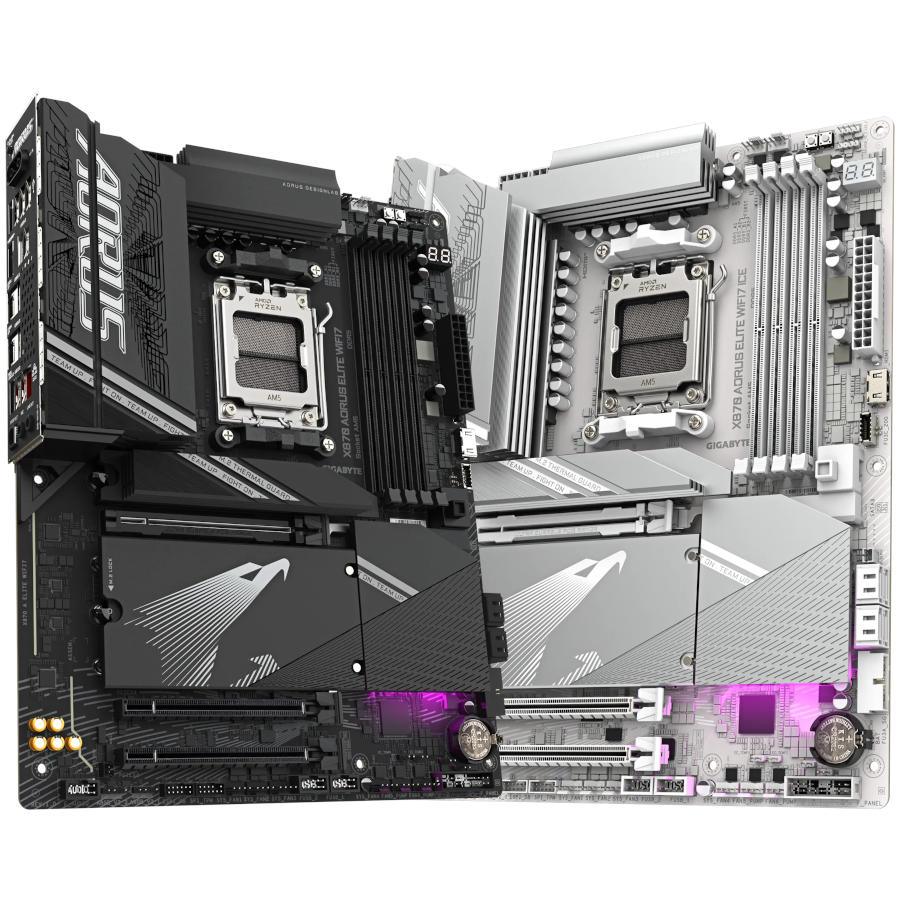
| Pros: | Cons: |
|---|---|
| 1. Excellent VRM capabilities; 2. PCIe and M.2 slots with Quick Release & Screwless Design 3. Dual USB4 USB Type-C ports; 4. Perfect motherboard if PCIe 5.0 SSD and USB4 are priorities over GPU performance; 5. Internal USB Type-C Header, with USB 3.2 Gen 2×2 support; 6. 7-segment display (Debug Code display) on all AORUS X870/X870E Motherboards; 7. All-White option; 8. Good amount of fast USB, expected on a nearly $300 motherboard. | 1. M.2 slots M2B_CPU and M2C_CPU share bandwidth with the PCIe X16 Slot. The PCIe 5.0 X16 slot will run at X8 speeds if either one of those M.2 Slots are occupied; 2. Only two M.2 slots (M2A_CPU and M2D_SB) can be used if full X16 bandwidth for GPU is required; 3. PCIEX4 shares bandwidth with M2D_SB, only one can be used at a time; 4. Only one USB 3.2 Gen 1 (Type-A) internal header (Supports up to 2x Type-A ports). 5. Bottom PCIe lane is PCIe 3.0 x2 6. Limitations on Wi-Fi 7 (11be 160MHz wireless standard) |
Specifications:
- 16(8+8)+2+2 Power Stages (60A)
- 2.5GbE LAN & Wi-Fi 7
- PCI Express 5.0 Support
Storage:
- 4x M.2 Slots
- 3x M.2 PCIe 5.0 x4 slot
- 1x M.2 PCIe 4.0 X4 slot
- 4x SATA 6Gb/s
USB Rear I/O:
- 2x USB4 (Type-C)
- 2x USB 3.2 Gen2
- 4x USB 3.2 Gen1
- 4x USB 2.0
Internal USB Header:
- 1x USB 3.2 Gen2x2 (Type-C)
- 1x USB 3.2 Gen1 headers (Supports 2x USB 3.2 ports)
- 2x USB 2.0 headers (Supports 4x USB 2.0 ports)

GIGABYTE X870E AORUS ELITE WIFI7
The GIGABYTE X870E AORUS ELITE WIFI7 improves on a few areas compared to the X870 AORUS ELITE, as it has more PCIe lanes to work with. The PCIe 4.0 x4 (PCIEX4_1) connector does not share bandwidth with the M2D_SB connector, meaning both can be used at the same time. A second USB 3.2 Gen1 internal header is added, and the bottom full-length PCIe connector now is a PCIe 3.0 x4 (X870 AORUS ELITE WIFI7 is PCIe 3.0 x2). It comes with the same quality of life features as the X870 model, and overall, they are quite similar in specs and features.
For those who need at least 3x PCIe 5.0 M.2 Slots at a more affordable price range, both GIGABYTE X870 AORUS ELITE WIFI7 and X870E AORUS ELITE WIFI are excellent AM5 motherboards, as the next best option is the ASUS ROG STRIX X870E-E GAMING WIFI, with five M.2 slots (3x M.2 PCIe 5.0 slots and 2x PCIe 4.0 x4) at a much higher $499.99 price tag.
Recommended for:
- Same as the X870 AORUS ELITE WIFI7, but who require more USB internal headers (compared to the X870 AORUS ELITE WIFI7) and can make use of the PCIe 4.0 x4 and PCIe 3.0 x4 slots
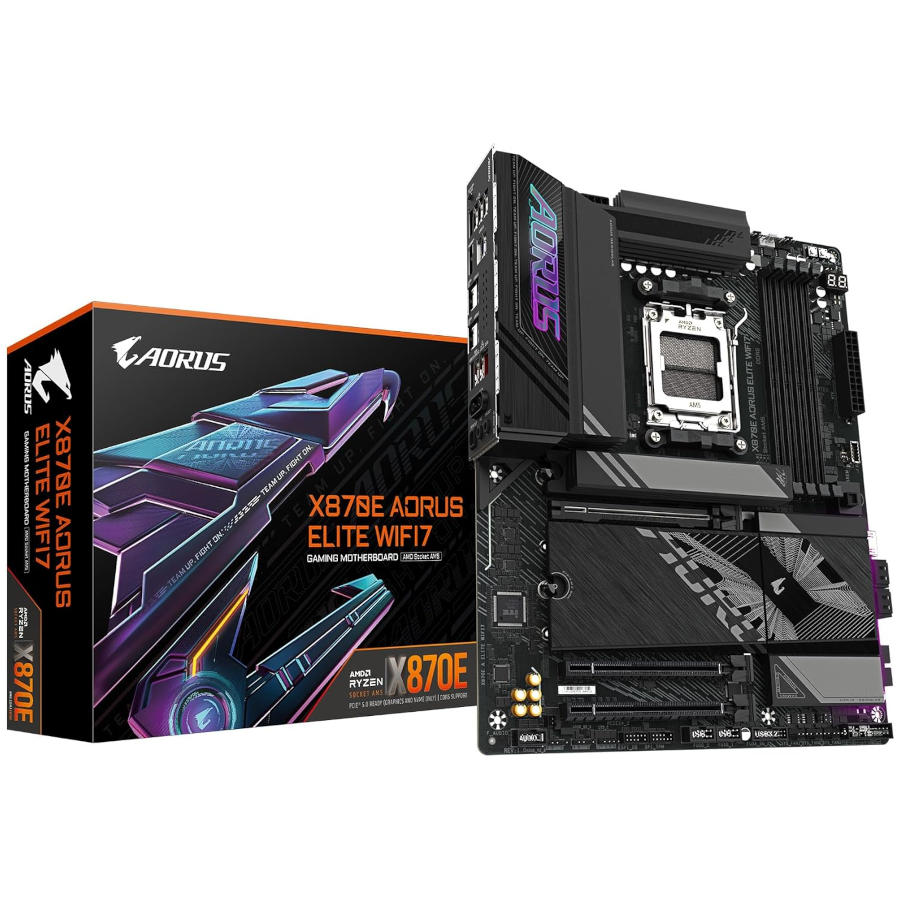
| Pros: | Cons: |
|---|---|
| 1. Exact same specifications and features as the X870 Aorus Elite WIFI7 2. More attention to visuals and aesthetics; 3. Full-length PCIe 3.0 x4 slot, instead of PCIe 3.0 x2; 4. Support to up to 4x Type-A USB 3.2 with additional USB 3.2 Gen 1 internal header 5. PCIe 4.0 x4 (PCIEX4_1) and M2D_SB connector can be used at the same time. | 1. M.2 slots M2B_CPU and M2C_CPU share bandwidth with the PCIe X16 Slot. The PCIe 5.0 X16 slot will run at X8 speeds if either one of those M.2 Slots are occupied; 2. Only two M.2 slots (M2A_CPU and M2D_SB) can be used if full X16 bandwidth for GPU is required; 3. Limitations on Wi-Fi 7 (11be 160MHz wireless standard) 4. $30 more expensive |
Specifications:
- 16(8+8)+2+2 Power Stages (60A)
- 2.5GbE LAN & Wi-Fi 7
- PCI Express 5.0 Support
Storage:
- 4x M.2 Slots
- 3x M.2 PCIe 5.0 x4 slot
- 1x M.2 PCIe 4.0 X4 slot
- 4x SATA 6Gb/s
USB Rear I/O:
- 2x USB4 (Type-C)
- 2x USB 3.2 Gen2
- 4x USB 3.2 Gen1
- 4x USB 2.0
Internal USB Header:
- 1x USB 3.2 Gen2x2 (Type-C)
- 2x USB 3.2 Gen1 headers (Supports 2x USB 3.2 ports)
- 2x USB 2.0 headers (Supports 4x USB 2.0 ports)

GIGABYTE X870E AORUS PRO and X870E AORUS PRO ICE
The GIGABYTE X870E AORUS PRO and GIGABYTE X870E AORUS PRO ICE carries all of the improvements the GIGABYTE X870E AORUS ELITE WIFI7 had over the X870 model, and add a few extra features.
Compared to the X870E AORUS ELITE WIFI7, the VRM now is even more overkill. Two USB 2.0/1.1 ports were removed from the rear I/O, and one USB 3.2 Gen 2 Type-A port was added. Wi-Fi 7 module is now a Qualcomm® Wi-Fi 7 QCNCM865, with support for the 11be 320MHz wireless standard (11be 160MHz standard on the previous AORUS models). Other than that, the X870E AORUS PRO is quite similar to the X870E AORUS ELITE WIFI7, with some visual diferences and improvements.
Recommended for:
- Same as the X870E AORUS ELITE WIFI7, but require full Wi-Fi 7 capabilities and don’t mind less USB 2.0 ports on rear I/O in favor of an additional USB 3.2 Gen 2 port (Compared to the X870E AORUS ELITE WIFI7)
- All-White option is also interesting, as there is not white option for the X870E AORUS ELITE WIFI7.
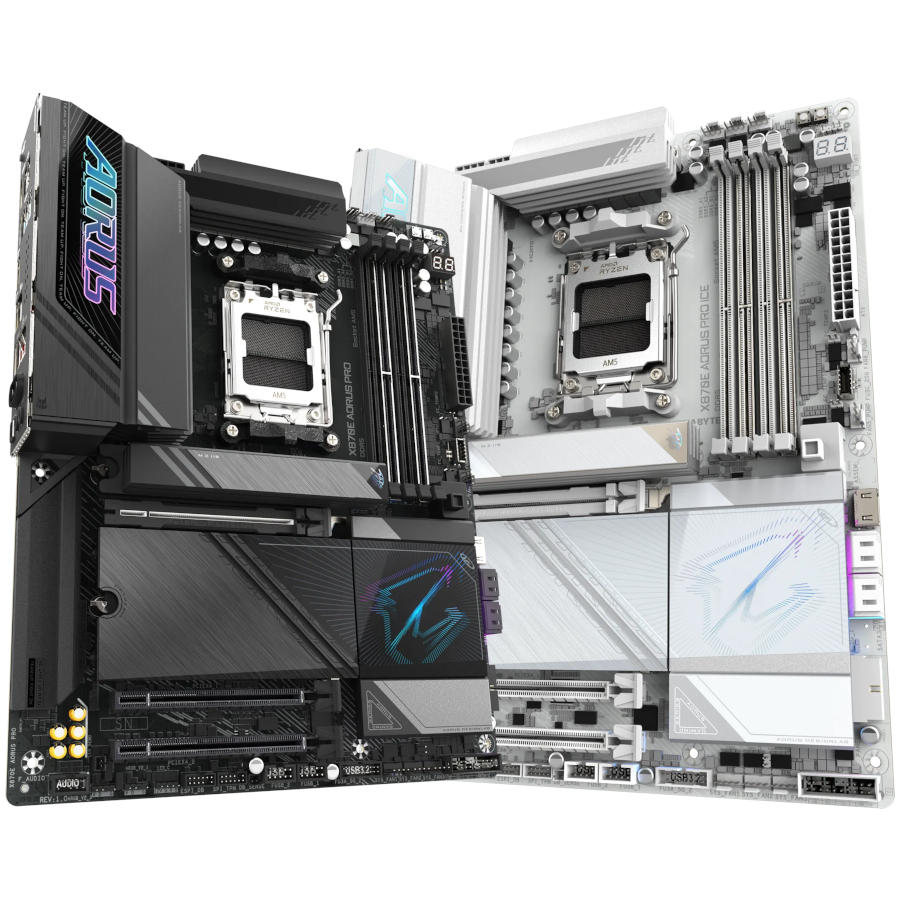
| Pros: | Cons: |
|---|---|
| 1. Upgraded and overkill VRM capabilities; 2. Support for 11be 320MHz wireless standard 3. PCIEX4_1 does not share bandwidth with M2D_SB 4. Temperature sensor headers 5. One extra USB 3.2 Gen 2 Type-A port on rear I/O (compared to the X870E AORUS ELITE) 6. All-White option; | 1. M.2 slots M2B_CPU and M2C_CPU share bandwidth with the PCIe X16 Slot. The PCIe 5.0 X16 slot will run at X8 speeds if either one of those M.2 Slots are occupied; 2. Only two M.2 slots (M2A_CPU and M2D_SB) can be used if full X16 bandwidth for GPU is required; 3. Still is a 6-layer PCB Motherboard 4. Less USB 2.0 connectivity on rear I/O (compared to the X870E AORUS ELITE) 5. Steep pricing. 6. If 320MHz wireless standard support is the main reason for purchase, MSI X870/X870E lineup might be a better option. |
Specifications:
- 16(8+8)+2+2 Power Stages (80A)
- 2.5GbE LAN & Wi-Fi 7
- PCI Express 5.0 Support
Storage:
- 4x M.2 Slots
- 3x M.2 PCIe 5.0 x4 slot
- 1x M.2 PCIe 4.0 X4 slot
- 4x SATA 6Gb/s
USB Rear I/O:
- 2x USB4 (Type-C)
- 3x USB 3.2 Gen2
- 4x USB 3.2 Gen1
- 2x USB 2.0
Internal USB Header:
- 1x USB 3.2 Gen2x2 (Type-C)
- 2x USB 3.2 Gen1 headers (Supports 2x USB 3.2 ports)
- 2x USB 2.0 headers (Supports 4x USB 2.0 ports)

GIGABYTE X870E AORUS MASTER
The GIGABYTE X870E AORUS MASTER is GIGABYTE flagship model, at least so far. It carries all the improvements of the X870E AORUS PRO, and keeps adding on top of that.
One of the main improvements is the 8-Layer PCB, providing improved signal integrity and better memory overclocking capabilities. Other than that, upgraded VRM, 5GbE LAN, beefier M.2 heatsink, beefier VRM heatsink, magnetic attachment system (M.2 EZ-Match) for M.2 slots cover and active cooling for memory (DDR Wind Blade) are some of the other improvements included with this motherboard.
The AORUS MASTER makes life a bit easier for those who are overclocking, adding support for a few monitoring tools and a Clear CMOS button in the back I/O. It does not make an effort to be a dual purpose motherboard for workstation applications, it’s main focus seems to be overclocking and gaming, as it does not offer dual LAN, extra USB Type-C ports, or PCIe 5.0 bifurcation, something other motherboards in it’s price range will offer.
- If you are looking for a motherboard with a good mix of gaming and workstation capabilities, you might want to take a look at the ASUS ProArt X870E-CREATOR WiFi, the MSI MPG X870E CARBON WIFI and the ASRock X870E Taichi Lite. They offer gaming workstation users a better set of features at a similar price range.
Recommended for: Overclocking, high-end/showcase gaming builds.
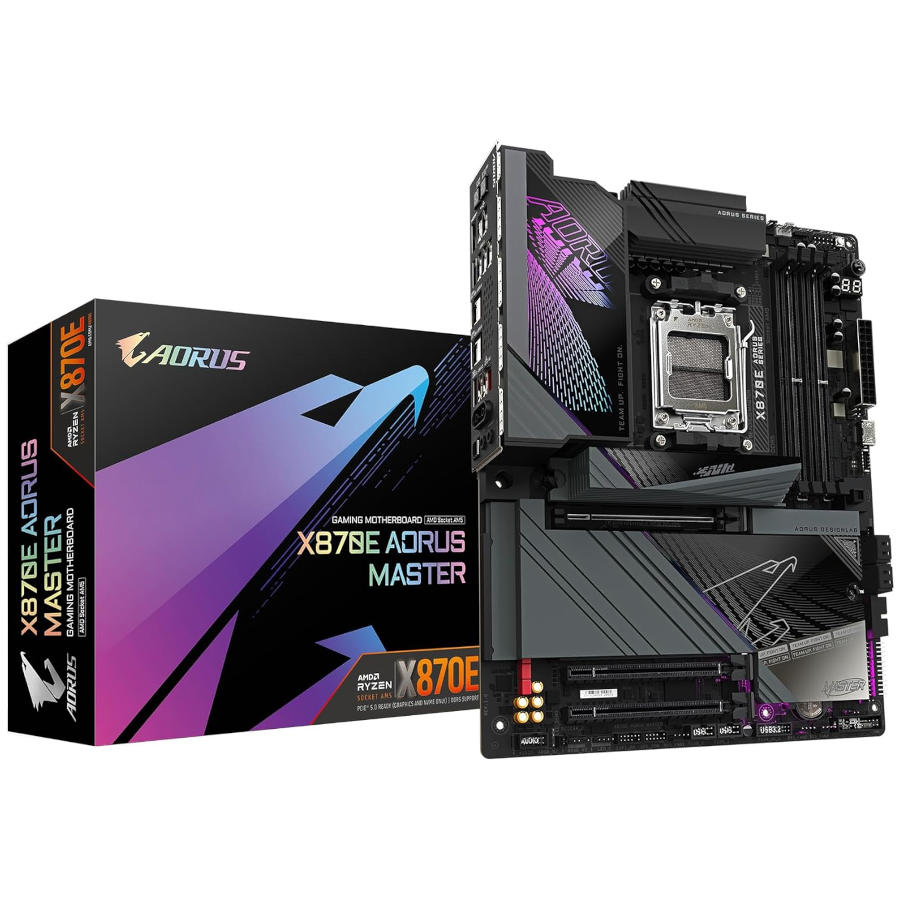
| Pros: | Cons: |
|---|---|
| 1. Even more overkill VRM capabilities; 2. Support for 11be 320MHz wireless standard 3. 8-Layer PCB and improved memory support 4. Beefier M.2 and VRM heatsink 5. 5GbE LAN | 1. M.2 slots M2B_CPU and M2C_CPU share bandwidth with the PCIe X16 Slot. The PCIe 5.0 X16 slot will run at X8 speeds if either one of those M.2 Slots are occupied; 2. Only two M.2 slots (M2A_CPU and M2D_SB) can be used if full X16 bandwidth for GPU is required; 3. No PCIe bifurcation, no Dual LAN, no extra USB Type-C ports on rear I/O. 4. It is possible to find motherboards with PCIe bifurcation, Dual LAN and more USB-C ports in the same price range (ASUS ProArt X870E-CREATOR WIFI for example) |
Specifications:
- 16(8+8)+2+2 Power Stages (110A)
- 5GbE LAN & Wi-Fi 7
- PCI Express 5.0 Support
Storage:
- 4x M.2 Slots
- 3x M.2 PCIe 5.0 x4 slot
- 1x M.2 PCIe 4.0 X4 slot
- 4x SATA 6Gb/s
USB Rear I/O:
- 2x USB4 (Type-C)
- 3x USB 3.2 Gen2
- 4x USB 3.2 Gen1
- 2x USB 2.0
Internal USB Header:
- 1x USB 3.2 Gen2x2 (Type-C)
- 2x USB 3.2 Gen1 headers (Supports 2x USB 3.2 ports)
- 2x USB 2.0 headers (Supports 4x USB 2.0 ports)



